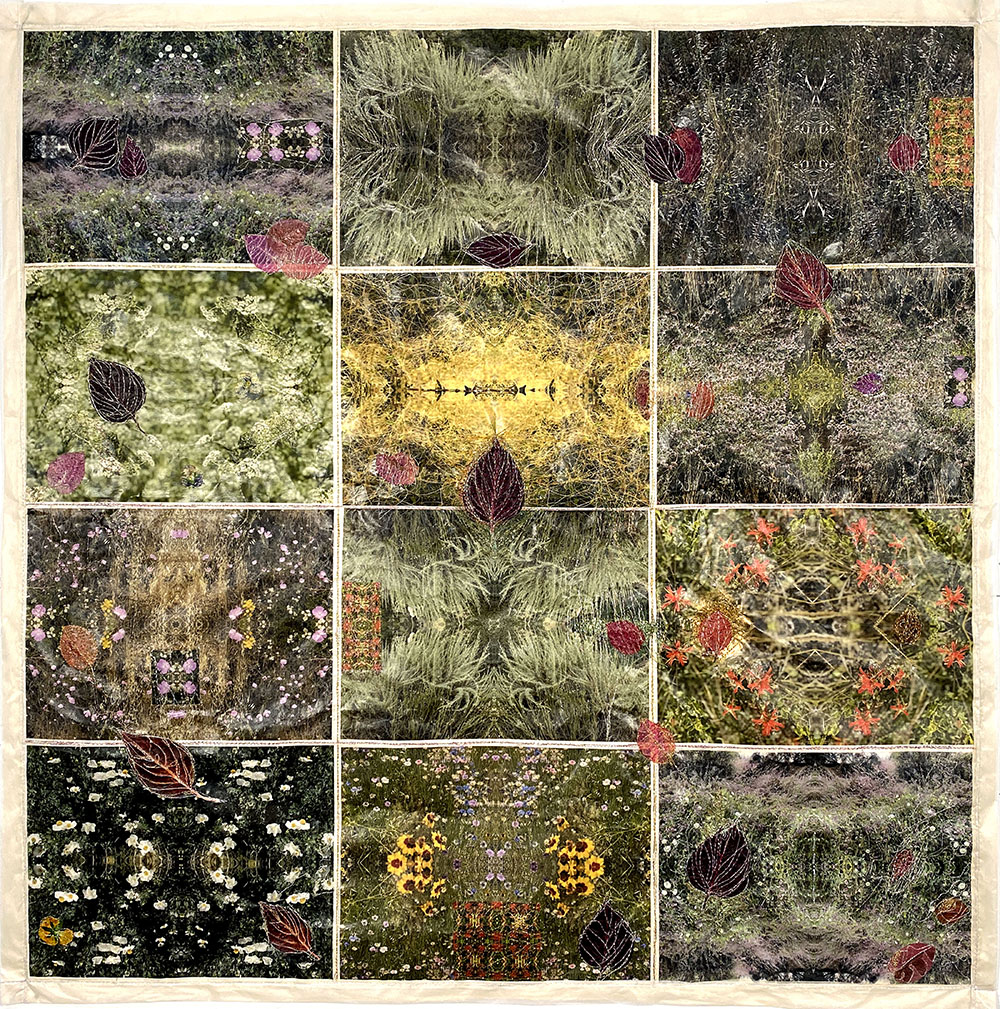The Artist Intervenes: Charlotte Schmid-Maybach

©Charlotte Schmid-Maybach, Puget Sound 13” x 16” Sewn archival inkjet print on kozo paper, metallic and mixed thread, 2019
Topography, or the study of the physical characteristics of land, represents landscapes through line. Sculptural in nature, topographic maps depict structural features as well as the more subtle imprints of place. Photographer and mixed media artist Charlotte Schmid-Maybach engages landscapes with similar attention to detail in her Phototapestries series, as she constructs intimately rendered, mixed-media topographies. Drawing inspiration from the Pacific Northwest, she prints landscape photographs on Kozo paper, then performs her artistic interventions with thread, paint, watercolor, and the occasional map.
Schmid-Maybach disrupts conventions of both sewing and photography in her work. The sewing follows no strict pattern, rather curls and undulates, emphasizing the inherent aliveness of the disparate landscapes. The source images themselves are also manipulated, cut and distorted. The photo tapestries are a study in form, attending to the multidimensionality and movement of the natural environment.
As Schmid-Maybach stitches together ecosystems, she underscores the permeability and interconnectedness of geography and place. Her commitment to illustrating the minute details of the landscapes by uniting multiple mediums displays her photojournalistic sensibilities. As she notes in her artist statement, the series is further evocative of fairy tales and historic road maps. Fantasy and reality converge in these reimagined landscapes as Schmid-Maybach traces ecosystems across time and space.
Charlotte Schmid-Maybach is a photographer and mixed media artist based in Los Angeles. Originally from San Francisco, she earned her BA from UC Berkeley in South Asian civilization and MA in photojournalism from the University of Missouri, Columbia. Her background as an archaeological photographer in Pakistan and fifteen years as a newspaper photojournalist have informed her artwork. Charlotte started studying with artist Tom Wudl in Los Angeles in 2016 and recently had a solo exhibition of her phototapestries at the Lois Lambert Gallery in Santa Monica. Her work has been shown at the Center for Photographic Art, the Colburn School of Music, the Neutra Institute Museum and is also held in private collections in the U.S.

©Charlotte Schmid-Maybach, Redwoods 13” x 16” Sewn archival inkjet print on kozo paper, metallic and mixed thread 2020
The seeds of this work started decades ago when I was living in Berkeley, experimenting with cutting my photographs and weaving in fibers and grasses. With this new body of work, the sewn threads integrate fully with the photographic images to create a new object: photographic tapestries.
I draw my inspiration from nature, the old growth forests of the Pacific Northwest and the crumbling walls at Fort Worden on Puget Sound. Fort Worden is a hundred year old bunker weathered by the ocean and time.
I begin by making archival inkjet prints on Japanese Kozo paper. The paper reminds me of high quality newsprint and brings me back to when I worked as a newspaper photojournalist. I paint the Kozo paper with a thin layer of acrylic medium to protect it from UV light and the sewing process. Then I begin to sew with various types of thread, mostly metallic thread.

©Charlotte Schmid-Maybach, Snow in Winter 60” x 40” Sewn archival inkjet prints on kozo paper, metallic and mixed thread, iridescent acrylic paint, lace, buttons 2021
Thread adds a different element and changes the images into something more dimensional and sometimes sculptural. The threads blur the line between what’s real in the photograph and what’s beyond or imagined in the past. When I started sewing the forest pictures with gold threads, it made me think of fairy tales and what happens in the forest when no humans are present.
Sometimes I add iridescent acrylic paint or watercolor, and lately I’ve been adding printed pieces of old topographic maps, marking the provenance of the photographs. The maps add to the quality of historic artifact and road map, and the topographic lines mimic the texture of the trees.
When a piece is almost finished I sew layers of tengu paper tape around the edges as a border. The sewing process is also about making something interesting out of the ordinary, and in doing so elevating the idea of sewing as women’s work to that of a higher art form. I like to think of my work as creating the artifacts of tomorrow. – Charlotte Schmid-Maybach

©Charlotte Schmid-Maybach, Lost Chickens 22” x 18” Sewn archival inkjet print on kozo paper, metallic and mixed thread 2019

©Charlotte Schmid-Maybach, Hoh Rainforest 18” x 23” Sewn archival inkjet print on kozo paper, metallic and mixed thread 2019

©Charlotte Schmid-Maybach, Rogue River Grid 28” x 35” Sewn archival inkjet prints on kozo paper, metallic and mixed thread, button 2020

©Charlotte Schmid-Maybach, Snowstorm in Church Yard 48” x 38” Sewn archival inkjet prints on kozo paper, metallic and mixed thread, iridescent paint 2020

©Charlotte Schmid-Maybach, Big Forest 62” x 50” Sewn archival inkjet prints on kozo paper, metallic and mixed thread, iridescent acrylic paint 2020

©Charlotte Schmid-Maybach, Black and Blue 23” x 18” Sewn archival inkjet prints on kozo paper, metallic and mixed thread, lace 2019

©Charlotte Schmid-Maybach, Flower Grid 34” x 34” Sewn archival inkjet prints on kozo paper, metallic and mixed thread, leaves, iridescent acrylic paint 2021

©Charlotte Schmid-Maybach, Fort Worden Grid 36”x 29” Sewn archival inkjet prints on kozo paper, metallic and mixed thread 2019

©Charlotte Schmid-Maybach, Midnight Snowstorm, Big Bang 22” x 17” Sewn archival inkjet prints on kozo paper, metallic and mixed thread, iridescent watercolor, buttons 2021
Posts on Lenscratch may not be reproduced without the permission of the Lenscratch staff and the photographer.
Recommended
-
Ragne Kristine Sigmond: Portraits of Painterly LightDecember 2nd, 2025
-
Mary Pat Reeve: Illuminating the NightDecember 1st, 2025
-
Ricardo Miguel Hernández: When the memory turns to dust and Beyond PainNovember 28th, 2025
-
Pamela Landau Connolly: Columbus DriveNovember 26th, 2025
-
MATERNAL LEGACIES: OUR MOTHERS OURSELVES EXHIBITIONNovember 20th, 2025


























































